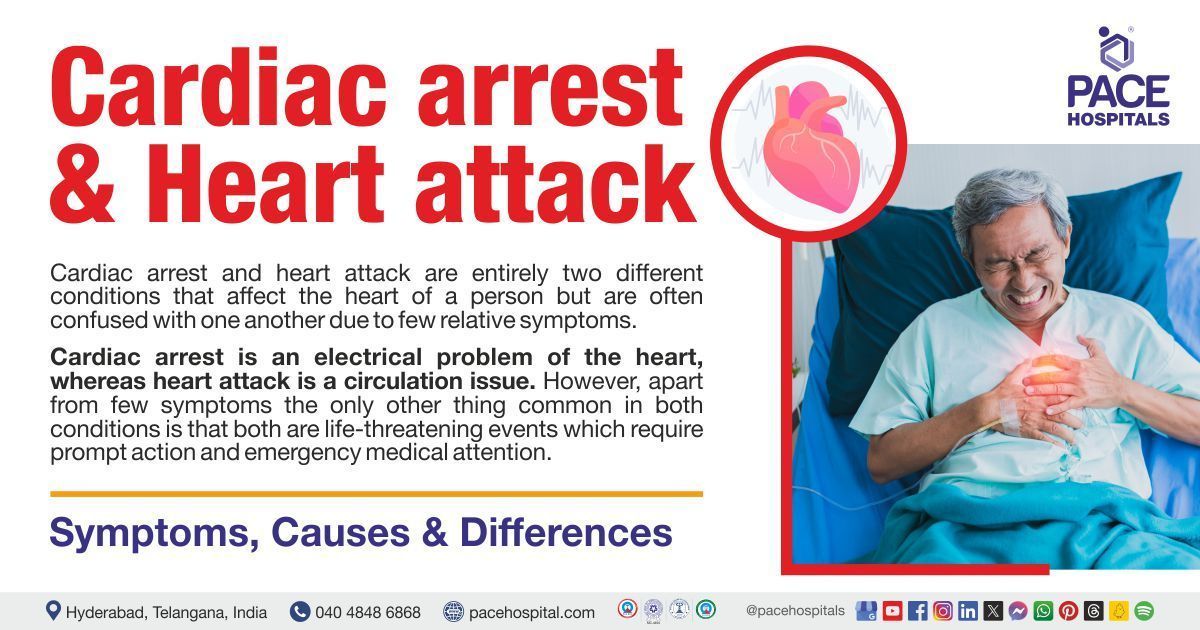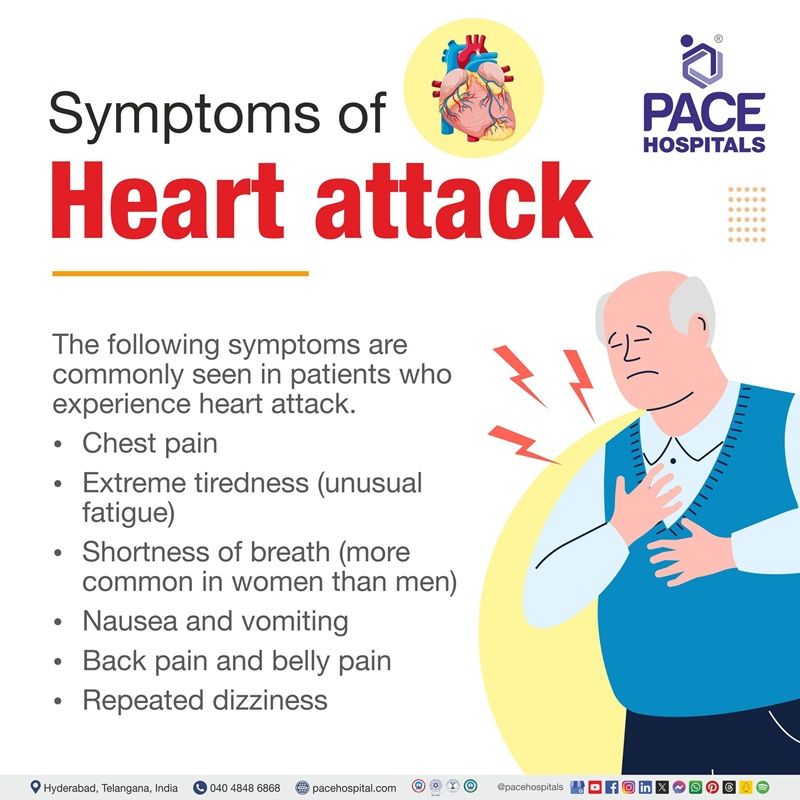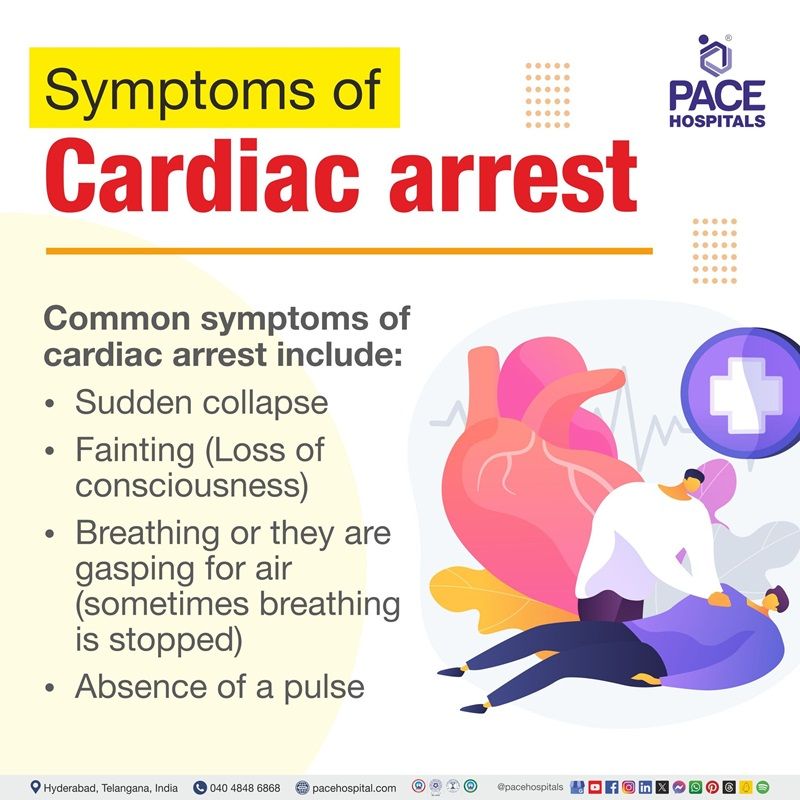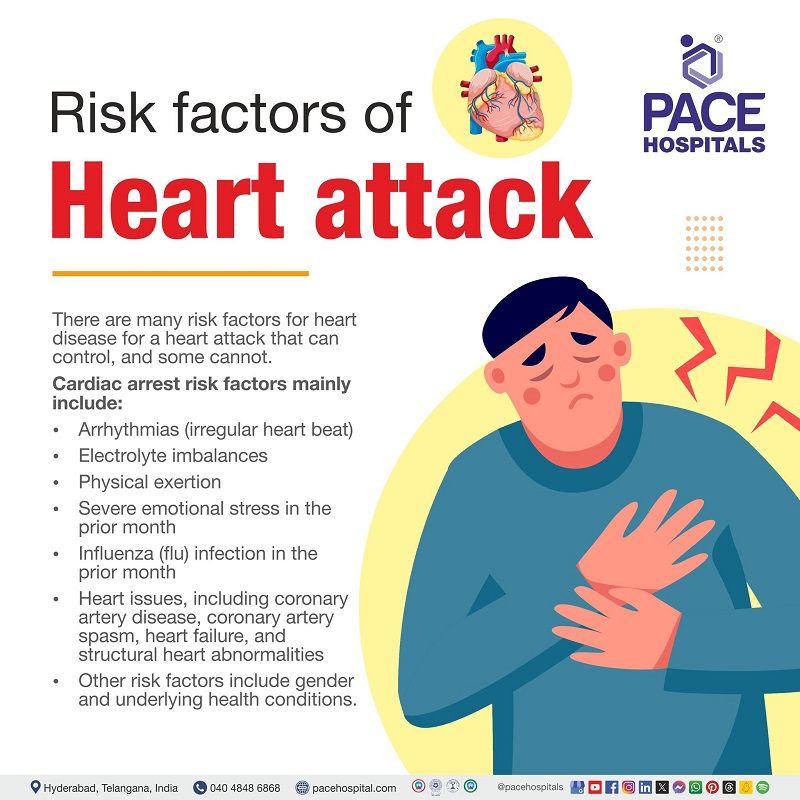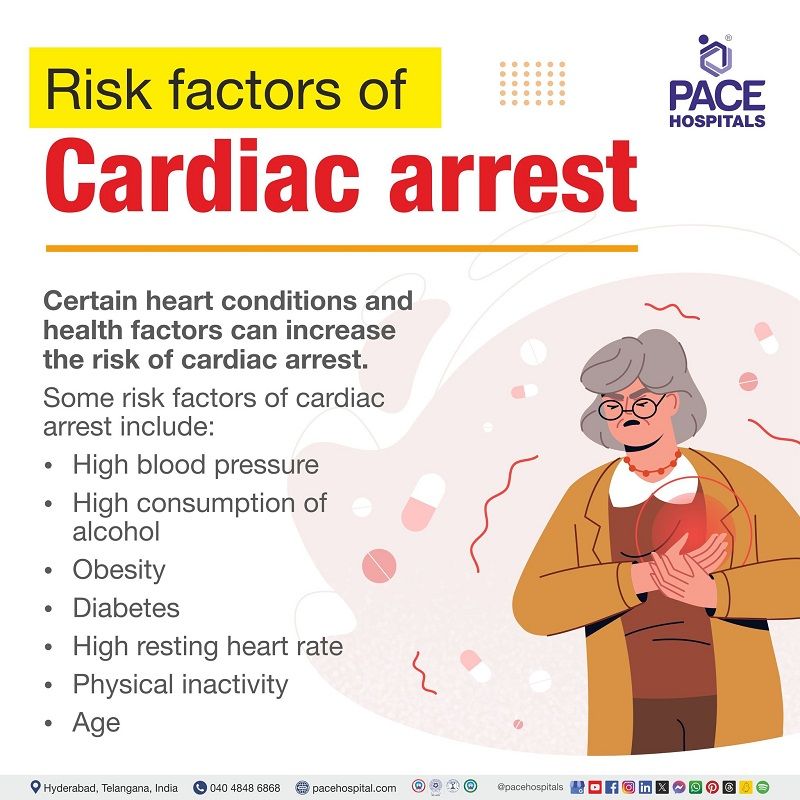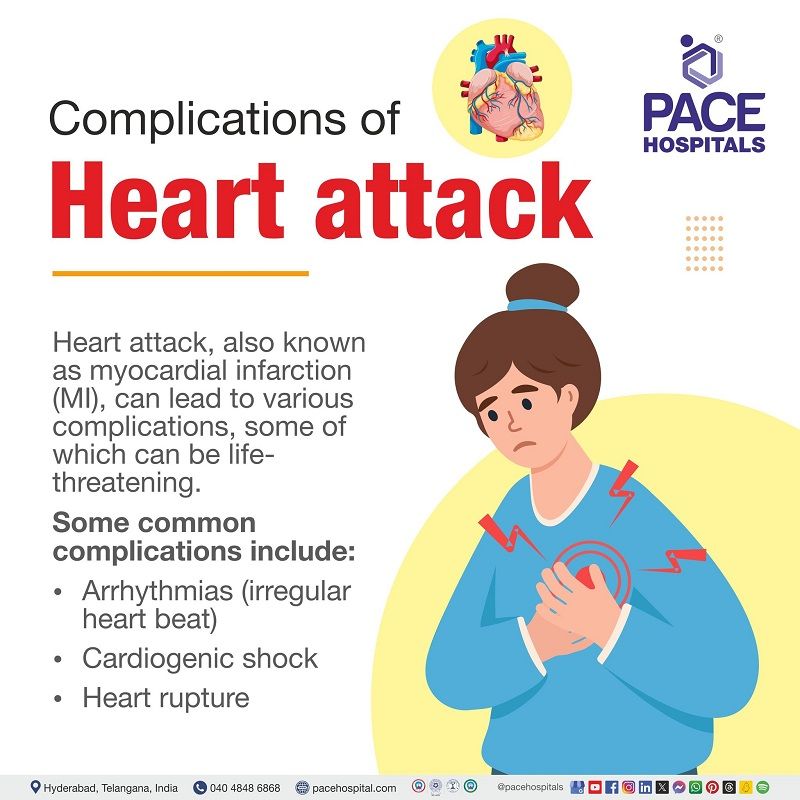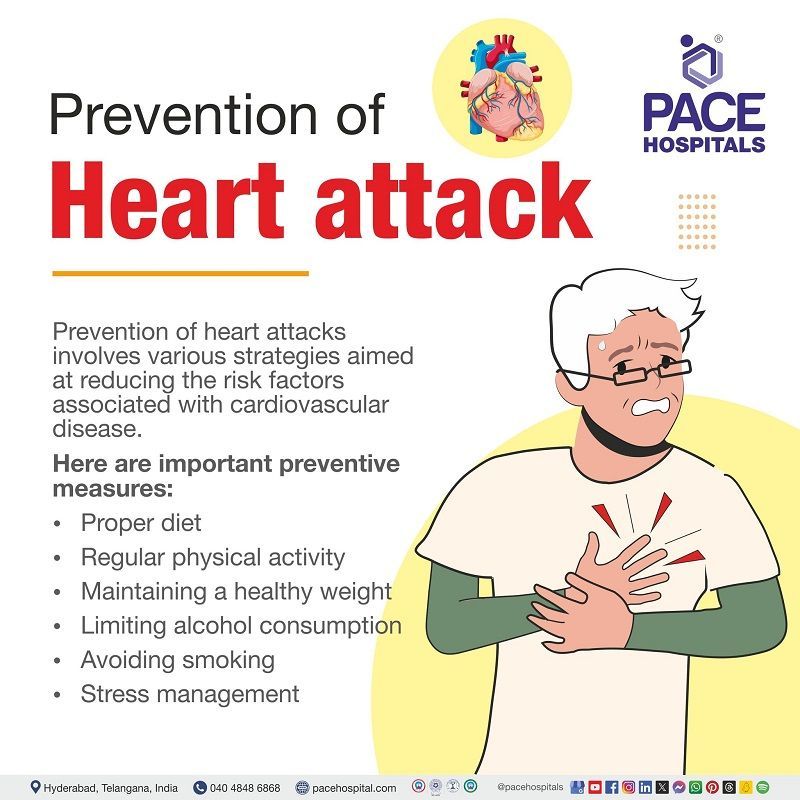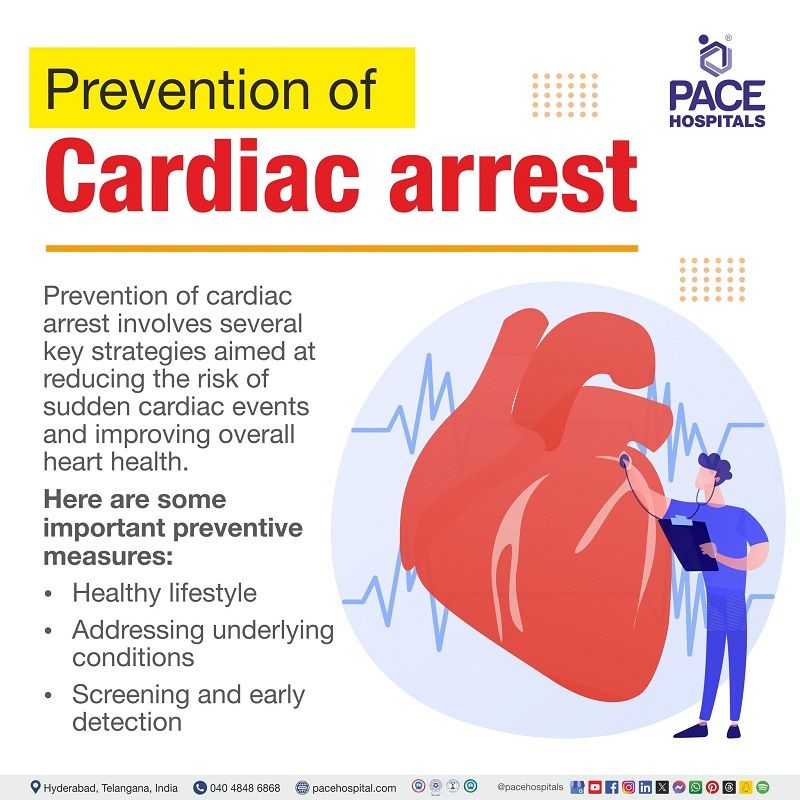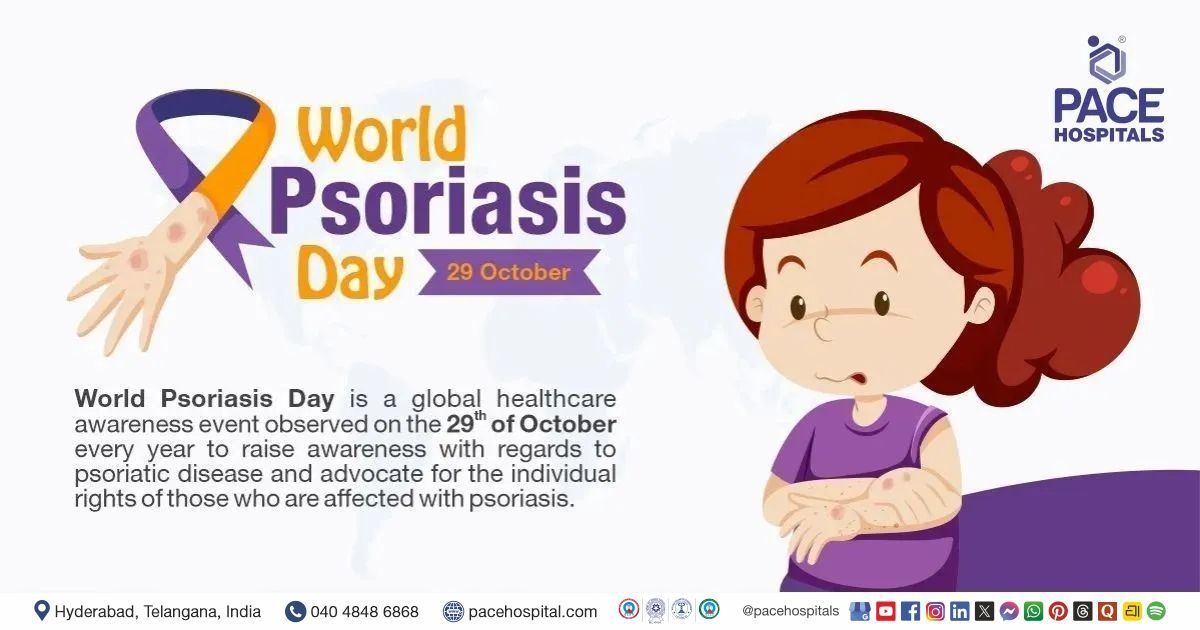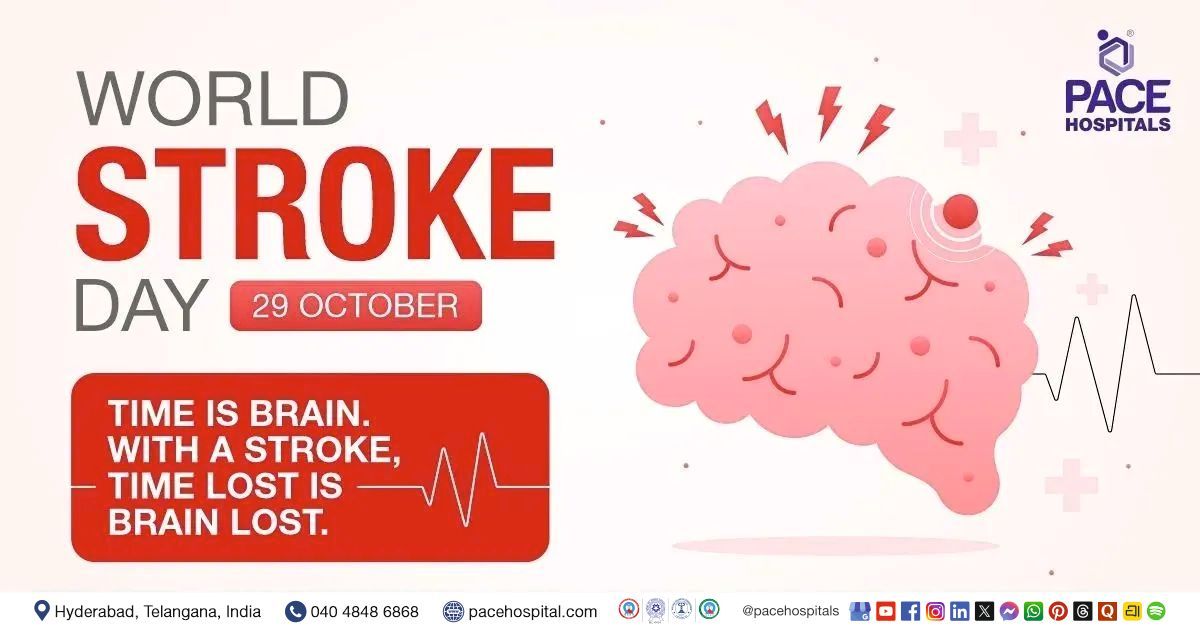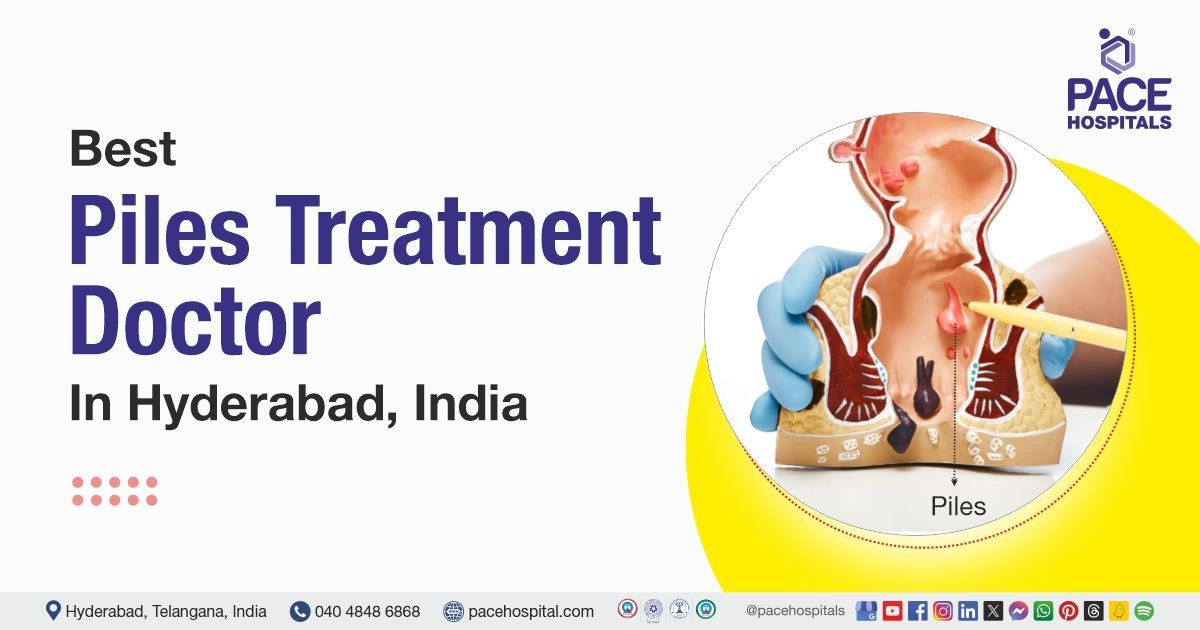Cardiac arrest & Heart attack - Causes, Symptoms, Differences and Treatment
Cardiac arrest and heart attack are entirely two different conditions that affect the heart of a person but are often confused with one another due to few relative symptoms. Cardiac arrest is an electrical problem of the heart, whereas heart attack is a circulation problem. However, apart from few symptoms, the only other thing common in both conditions is that both are life-threatening events which require prompt action and emergency medical attention.
Sudden death due to cardiac arrest represents one of the greatest challenges facing modern medicine, not only because of the sheer massive number of cases involved but also because of its tremendous social and economic impact. The association between cardiac arrest and coronary ischemia (heart attack) has been recognized for thousands of years. The Ebers Papyrus from Egypt, dating from approx. 1550 BCE, notes that, If a patient has pain in the arm and left side of the chest, there is a threat of death. An ancient Chinese medical text observes that an intermittent pulse is a predictor of imminent death.
Globally, around 11 crore men and eight crore women are suffering from coronary heart disease (CAD), which is a leading cause of death, taking an estimated 17.9 crore lives each year. It is estimated that the global annual occurrence of sudden cardiac death is in the range of 0.4-0.5 million cases per year.
More than seven million individuals globally suffer from heart attack each year. A 2019 study detected that the prevalence of heart attack to be around 23.3% with 19,781 CAD patients. Despite the popular opinion that cardiac arrest is the same as heart attack, which is quite often used interchangeably, this is far from reality. Hence, understanding the difference between these conditions is of the utmost importance. Knowing and recognizing the diversities could prove life-saving, if acted promptly.
Cardiac arrest
Cardiac arrest is an unexpected and sudden condition, often occurs without warning, where the person's heart stops pumping oxygen and blood to the brain and other organs of the body. It happens because of anything that makes the heart stop beating, including electrical malfunctions in the heart and severe heart attacks, which cause arrhythmia (irregular heartbeats). Within minutes, it causes the heart to stop beating.
Heart attack
A heart attack (medically termed as myocardial infarction or MI) is defined as impairment (damage) to part of the heart muscle (myocardium) caused by a shortage (insufficiency) of oxygen and blood flow to the area due to the blockage of the coronary arteries (a blood vessel that supplies blood to heart tissue). This shortage of oxygen and blood supply leads to the death of heart cells and causes chest pain. However, the heart usually beats in the heart attack condition, unlike cardiac arrest.
Relation between cardiac arrest and heart attack
It is usual for the common man to get panicked and get disoriented during any massive pain and discomfort arising in the chest area. In popular culture, too, the patients were shown in a fatal condition with repeated utterances of “heart attack” or “cardiac arrest”. These could fuel the confusion between both the conditions.
While a heart attack may cause cardiac arrest, heart attack on the other hand is not the only reason for cardiac arrest; there are other causes of cardiac arrest. This indicates that a heart attack may cause cardiac arrest, although not all cardiac arrests occur due to heart attacks. Sudden cardiac arrest may occur after a heart attack or during recovery because heart attacks raise the risk of sudden cardiac arrest.
Other heart conditions may disrupt the heart's rhythm and cause sudden cardiac arrest, and these include:
- Arrhythmias (irregular heartbeats) o Ventricular fibrillation o Long Q-T syndrome
- Heart failure
- Cardiomyopathy (thickened heart muscle)
Prevalence of heart attack and cardiac arrest in India
Among Indians, heart disease is the number one cause of mortality and a silent epidemic. 50% of all heart attacks in men happen under 50 years of age, and 25% of all heart attacks in men occur under 40 years of age. The Indian female diaspora too shares high mortality rates. Sudden cardiac death (SCD) is the foremost common cause of death in heart patients. It is roughly estimated that about 7 lakh sudden cardiac deaths occur yearly in India. If the patient survives a sudden cardiac death, it is called as sudden cardiac arrest.
Common warning signs of cardiac arrest and heart attack
Some patients who had a cardiac arrest may experience one or more symptoms in the hour before the event. Some signs and symptoms may even appear a few weeks before a cardiac arrest. However, cardiac arrest could also be asymptomatic.
Common symptoms of a heart attack
Heart attack symptoms can vary between men and women. These are the common symptoms of a heart attack:
- Extreme tiredness (unusual fatigue)
- Shortness of breath (more common in women than men)
- Heart palpitations, or feeling as the heart is racing, fluttering, or skipping a beat
- Nausea and vomiting
- Back pain and belly pain
- Repeated dizziness
According to a new research article published by the Annals of Internal Medicine, it was found that more than half of people who have a sudden cardiac arrest might ignore the signs and symptoms that occur up to a month before the usually fatal heart rhythm malfunction.
It is recommended to consult a cardiologist if the person is experiencing the warning signs, such as fainting or chest pain, because that might signal a higher risk of cardiac arrest or heart attack.
Common symptoms of cardiac arrest
Cardiac arrest is a life-threatening condition in which the heart suddenly stops pumping blood. If anyone experience any of the following symptoms, reach emergency services immediately:
- Sudden collapse
- Fainting (Loss of consciousness)
- Breathing, or they are gasping for air (sometimes breathing is stopped)
- Absence of pulse
Distinguishing symptoms of a cardiac arrest and heart attack
Symptoms of cardiac arrest and heart attack may appear the same, but they have a few differences. Many people often confuse the warning signs of cardiac arrest with physical exhaustion.
- Onset of symptoms: The key differentiation lies in the onset of symptoms. Usually, cardiac arrests happen suddenly (sudden onset) without warning. They may occur in young people unaware of an underlying heart problem, which could be the first sign of a problem in the heart. However, not all heart attacks begin with the sudden and crushing chest pain that occurs when the blood flow to the person's heart gets blocked. Usually, symptoms of a heart attack are not sudden but may start slowly and can be mild or more serious. They may also come and go over several hours (gradual onset). Nevertheless, heart attack symptoms could differ from person to person and between men and women.
- Presence of crushing pain: Another prominent distinguishing factor in diversifying cardiac arrest from heart attack is crushing pain. This crushing pain may not be felt in cardiac arrest patients, but is a key symptom in heart attack patients. Most heart attacks involve discomfort or pain in the center or left side of the chest; it feels like squeezing, uncomfortable pressure. The pain radiates from the chest to the arms, usually the left arm, sometimes both arms, jaw, neck, back, and tummy.
- Loss of consciousness: Similarly, loss of consciousness is a de facto factor in distinguishing cardiac arrest from heart attack. While cardiac arrest may cause loss of consciousness in the patients within a few minutes due to deficiency of blood flow to the brain and other organs, heart attack patients may not lose consciousness during the episode.
The following table will differentiate the common symptoms seen during cardiac arrest and heart attack events and provide more detailed information to the people regarding the symptoms, whether they are present or not, to recognize them and act quickly.
| Symptoms | Cardiac arrest | Heart attack |
|---|---|---|
| Onset of symptoms | Sudden | Gradual |
| Loss of consciousness | ✓ | X |
| Sudden collapse | ✓ | X |
| No pulse | ✓ | X |
| No breathing | ✓ | X |
| Seizures | ✓ | X |
| Palpitations | ✓ | ✓ |
| Light headedness | ✓ | ✓ |
| Weakness | ✓ | ✓ |
| Sweating | X | ✓ |
| Chest pain | X | ✓ |
| Anxiety | X | ✓ |
| Coughing | X | ✓ |
In critically ill patients, cardiac arrest is often preceded by getting worse quickly with rapid shallow breathing, low blood pressure, and a progressive decrease in mental alertness (mentally low alertness).
However, in sudden cardiac arrest, collapse may occur without warning, occasionally with brief myoclonic jerks (jerking movements) or other seizure-like activity.
Causes of a cardiac arrest and heart attack
Cardiac arrest and heart attack are two different problems with radically different causes; knowing and understanding the causes are important for recognition, which is highly required for the patients to access timely treatment.
Cardiac arrest causes
Usually, electrical signals control the beating of the heart. Any disruptions in the electrical activity/ signals can hinder the regular beating of the heart. Disruptions usually occur when the nerve cells that produce electrical signals are either incapacitated or when there is some difficulty in the transfer of electrical signals through the heart.
The cardiac arrest is the condition of sudden interruption of cardiac activity due to which the patient enters into a catatonic state and becomes unresponsive. Regular breathing is also disrupted, and signs of circulation could be absent.
Most of the cardiac arrests mainly caused by the diseased heart’s electrical system malfunctions, such as ventricular fibrillation or ventricular tachycardia (rapid heartbeats in lower chambers of the heart). When the heart's electrical system fires very rapidly and in an uncoordinated manner, it renders the heart incapable of pumping blood through the circulatory system. This disruption in blood supply and oxygen to different organs in the body, including brain, lead to death within minutes.
Commonly, cardiac arrest may occur from the following conditions:
- Sudden malfunction in the heart's electrical system: Causes life-threatening arrhythmias (changes in the heart rhythm) such as ventricular fibrillation or ventricular tachycardia (rapid heartbeats in lower chambers)
- Electrolyte imbalance (magnesium, potassium, or other minerals in the blood)
- Clot in the lungs
- Heart failure
- Blow to the chest
- Drug overdose
Other sudden cardiac arrest causes include coronary artery disease, pacemaker failure, respiratory arrest, electrocution, hypothermia (low body temperature), drowning, and choking.
Heart attack causes
Heart attacks often develop from underlying conditions such as atherosclerosis. Atherosclerosis is the builds up of plaque (a waxy substance) inside the arteries over years, which can block the blood flow. Atherosclerosis can form in any artery, but if it forms in a coronary artery, it can hinder the flow of blood to myocardium (heart muscle). When the heart is not getting enough blood, it experiences hypoxia (low oxygen). Since oxygen supply is blocked, the damage intensifies, killing the myocardium (heart muscle). This condition is known as heart attack.
However, not all heart attacks are caused by blockages from atherosclerosis in coronary artery.
Atherosclerosis in other blood vessels can also cause heart attacks. In that case, it is called MINOCA – myocardial infarction in the absence of obstructive coronary artery disease, which is very common in women and young people.
The following conditions can cause MINOCA to have different effects on the heart.
- Small plaques
- A sudden and serious spasm (tightening) of the coronary artery •A coronary artery embolism:
- Spontaneous coronary artery dissection (SCAD): A tear inside the coronary artery
Risk factors for cardiac arrest and heart attack
While there has been an identification of matching risk factors between heart attack and cardiac arrest, both of which primarily disrupt the basis of heart functioning, there are nevertheless a few but distinct risk factors that enhance the deterioration of the respective conditions.
Hence, it is necessary to be aware of the risk factors of both conditions to detect and prevent them effectively.
The following are the predisposing (risk factors) factors of cardiac arrest and heart attack that are commonly known in either of the conditions:
- High blood pressure: Elevated blood pressure has been linked with a raised risk of sudden cardiac arrest and heart attack.
- High consumption of alcohol: Alcoholism is one of the significant risk factors for a healthy heart, as it increases blood pressure, straining the heart muscle and leading to cardiac disease. Cardiac rhythm is the first aspect to be disturbed by alcoholism, and research indicates that a sizeable proportion of sudden cardiac deaths (SCD) occur after chronic alcoholism.
- Obesity: Excess weight leads to the formation of fatty material in the arteries, clogging the blood vessels further, resulting in a heart attack and form cardiac arrest in the long term
- Diabetes: Diabetes patients are more vulnerable to certain conditions, including high cholesterol or high blood pressure, raising the chances of stroke or heart attack. Long-term effects of type 2 diabetes lead to congestive heart failure and coronary heart disease that predispose to sudden cardiac death.
- High resting heart rate: Higher resting heart rate (HR) levels have been linked with sudden cardiac death (SCD); however, mechanisms are poorly understood. Resting heart rate is associated with the risk of coronary artery disease, stroke, sudden death, and non-cardiovascular diseases.
- Physical inactivity: Being inactive is associated with obesity and is a significant risk factor for many cardiac conditions.
- Age: Aging causes changes in the blood vessels and heart that may raise the risk of cardiovascular disease
Cardiac arrest risk factors mainly include
- Arrhythmias (irregular heart beat)
- Electrolyte imbalances
- Physical exertion
- Severe emotional stress in the prior month
- Influenza (flu) infection in the prior month
- Heart issues, including coronary artery disease, coronary artery spasm, heart failure, and structural heart abnormalities
- Other risk factors include gender and underlying health conditions.
Vigorous physical activity, especially in men who do not exercise regularly, and alcohol misuse are most often (main triggers) associated with cardiac arrest. About 2 in every 20 cardiac arrest cases are linked with physical exertion, and up to 3 in every 20 cardiac arrests are linked with alcohol intake.
Heart attack risk factors mainly include the conditions causing heart muscle weakening or damage, such as:
- Coronary artery disease (CAD)
- Diabetes
- High blood pressure
- Obesity • Tobacco use, and • Valve disorders.
As mentioned above, high blood pressure, diabetes, obesity, and tobacco use are some of the important risk factors that lead to major risk factors such as coronary artery disease (CAD), which is a condition that causes heart muscle weakening or damage.
Complications of cardiac arrest and heart attack
Cardiac arrest is the complication of heart attack, which is often life-threatening. In patients who have ST elevation on the initial electrocardiogram (ECG), cardiac arrest is usually due to acute vessel occlusion.
Cardiac arrest patients, even with optimal care, have a substantially higher mortality rate than patients with STEMI without cardiac arrest. Despite being one of the most important predictors of mortality in patients with myocardial infarction (heart attack). Cardiac arrest is not included in many acute myocardial infarction risk adjustment models, although its inclusion improves mortality prediction.
Complications of cardiac arrest
Blood flow and oxygen are diminished to the vital organs of the patient, causing potential damage to the brain or organ dysfunction in the case of cardiac arrest. Most individuals who experience cardiac arrest might not survive. Among those who do, there is a risk of the following:
- Brain injury
- Neurologic dysfunction
- Disorders of consciousness
- Changes in quality of life
- Disturbances of consciousness
- Physical and psychological well-being
Other survivors might experience brain injuries due to diminished flow of blood and oxygen to the brain, leading to movement disorders, speech difficulties, speech difficulties, weakness or immobility, memory loss or impairment, and cognitive impairments such as difficulties with attention, concentration, and visual-motor skills, anxiety, and post-traumatic stress disorder (PTSD).
Heart attack complications
While, heart attack complications primarily focus on damage or injury to the heart muscle, possible heart failure, and related heart problems due to decreased blood flow.
Complications of heart attack include as follows:
- Arrhythmias (irregular heart beat)
- Cardiogenic shock
- Heart rupture
These complications might happen quickly after a heart attack and cause death. Sometimes, people may die suddenly from a complication of a heart attack before reaching the hospital or within the first month after a heart attack. However, many people might survive with treatment.
Diagnosis of cardiac arrest and heart attack
Managing the symptoms or symptomatic treatment might be temporary, but identifying the underlying root cause and addressing them is essential for long-term results.
Both cardiac arrests and heart attacks are conditions that are highly dangerous and prove fatal to the patient within minutes or hours. Hence, it is necessary to identify risk factors and manage them to avoid these conditions. As mentioned above, there are many common predisposing factors that are required to prevent future heart attacks or cardiac arrests.
Cardiac arrest diagnosis
The diagnosis of cardiac arrest first involves the checking the patient pulse, breath, and consciousness to confirm the signs and symptoms of cardiac arrest.
Emergency responders do the following tests immediately after patient entering into the emergency ward:
- Physical examination
- Medical history
- Electrocardiogram (test)
Afterward, they give the initial treatment, such as immediate resuscitation, to stabilize the patient. After stabilizing the patient, a cardiologist might also order other tests to examine the patient's condition, choose the proper treatment plan, and decrease the risk of complications or death. That tests may include as follows:
- Electrophysiology (EP) study
- Cardiac catheterization
- Blood tests
- Holter monitor
- Imaging tests
- Genetic testing
- Heart tests such as stress tests • Cardiac event monitoring.
Heart attack diagnosis
Patients who report to the emergency ward or any casualty department with chest pain or discomfort may have a following tests to evaluate symptoms, to detect blocked blood vessels and to measure cardiac enzymes, such as:
- Electrocardiogram (ECG)
- Physical examination
- Medical history
- Coronary angiography
- Blood tests
- Imaging tests
- Cardiac enzyme tests
Treatment of cardiac arrest and heart attack
Cardiac arrest and heart attack treatment are critical for the survival of patients, which involves emergency treatment with cardiopulmonary resuscitation; treatment depends on the patient's condition and may require different treatments due to their distinct causes and the nature of both conditions.
Cardiac arrest treatment
Cardiac arrest treatment needs prompt action by emergency medical team or by cardiologist to restore the heart's rhythm and function through cardiopulmonary resuscitation (CPR), automated external defibrillator (AED), and advanced medical support. Other cardiac arrest treatment involves
- Medications
- Airway management
- Advanced medical procedures to stabilize the patient
Heart attack treatment
Heart attack treatment mainly concentrates on restoring blood flow to the heart by opening the narrowed or blocked coronary arteries and minimizing the damage to the myocardium (heart muscle). However, both conditions require immediate attention, and treatment options may vary. Heart attack treatment includes:
- Medications
- Angioplasty and stenting
- Coronary artery bypass surgery (CABG)
Other than emergency treatments, there will be the availability of other treatment options for heart attack and cardiac arrest, which may not be the same for all patients; cardiologists choose the treatment options based on the patient's overall condition.
Prevention of cardiac arrest and heart attack
The prevention of cardiovascular diseases is by far the most cost-effective investment which the individual invests in his/her health. Similar to the symptoms, the prevention profile of both the diseases are almost identical since the preventative measures boost up cardio protection.
While the prevention of heart attack mainly lies in the avoidance of blockages in the coronary arteries, the prevention of cardiac arrest, on the other hand, must be a medically regulated affair. The patients may require the assistance of internal cardioverter defibrillators, which suppress ventricular tachyarrhythmias.
Nevertheless, the management of risk factors is a common goal in the prevention of either of the conditions and electrical problems. Healthy lifestyle choices benefit both conditions, but physical activity or exercise modifications might be needed to prevent cardiac arrest. However, these modifications may depend on the patient's age, overall health, etc.
Prevention of cardiac arrest
Cardiac arrest is sudden and unexpected, so the individual with risk factors needs to keep a lookout for the warning signs and overall health. It is possible to prevent sudden cardiac arrests by following some preventive measures, such as:
- Healthy lifestyle
- Addressing underlying conditions
- Screening and early detection
- Implantable devices (defibrillators)
- Medications
Prevention of heart attack
The following are the preventive measures for heart attack, which help in reducing the risk of blockages and underlying conditions:
- Proper diet
- Regular physical activity
- Maintaining a healthy weight
- Limiting alcohol consumption
- Avoiding smoking
- Stress management
- Controlling underlying conditions: (Blood pressure, cholesterol, and diabetes) • Medications
Difference between heart attack and cardiac arrest
Cardiac arrest vs heart attack
Cardiac arrest and heart attack are the conditions that cause damage to the heart. Although these are similar, they have some differences:
| Particulars | Heart attack | Cardiac arrest |
|---|---|---|
| What happens during the event | It is characterised by damage to the portion of the heart muscle due to blockage of coronary arteries disrupting the blood flow and oxygen to it. | It is characterized by the sudden stoppage of heart function, leading to a cessation of blood circulation. |
| Often occurs due to? | Coronary artery disease (blockage of coronary arteries) | Irregular heart rhythms (electrical malfunction) |
| Symptoms | Often presents with symptoms such as chest pain or discomfort, shortness of breath, and cold sweats. | Most cardiac attacks may occur suddenly with the unexpected loss of consciousness, pulse, and breathing. |
| Fatality | If the blood flow isn't restored quickly, this condition also can become fatal. | It can be dangerous if it is not treated within minutes. |
| Treatment | It may be treated by medications, coronary angioplasty, or surgery to unblock the artery. | It requires immediate defibrillation and CPR |
| Onset | It often precedes with warning signs such as chest pain or discomfort. | It occurs without any warning signs or symptoms. |
Early diagnosis and treatment are crucial for both heart attack and cardiac arrest. If you have any concerns, don't hesitate to seek medical attention. ✅ Request an appointment.
Request an appointment for heart attack or cardiac arrest
FAQs - Frequently asked questions
What to do in cardiac arrest?
Cardiac arrest can be lethal if it lasts more than 8 minutes without treatment (CPR)., and Brain damage also may occur after 5 minutes. Treatment for cardiac arrest has to start right away, even if the person is not in the hospital. If the person is in a public area such as a movie theatre, playground, railway station, school, or mall, Performing the automated external defibrillator (AED) and CPR will help.
An automated external defibrillator is a medical device that a person can use without medical training to shock someone else's heart. Before producing the shock, the AED ensures the absence of a heartbeat. It is ideal for one person to operate the AED while another one calls for emergency help.
Can heart failure cause cardiac arrest?
Yes, heart failure may cause cardiac arrest because the complication of heart failure is cardiac arrest, and it occurs when the ability of the heart to pump blood effectively is very badly compromised, leading to life-threatening irregular heartbeats, which may lead to cardiac arrest. Therefore, managing the heart failure is needed to reduce the risk of cardiac arrest.
Can anyone get cardiac arrest?
Yes, sudden cardiac arrest may happen to anyone at any time, regardless of age or sex. Some persons may have a higher risk of getting cardiac arrest due to unaddressed cardiac issues, drug abuse, trauma, underlying health conditions, or electrolyte imbalances, making cardiac arrest a possible threat to anyone at any time.
Why heart attack after COVID-19?
According to some studies, it was suggested that SARS-CoV-2 may increase the risk of stroke and heart attacks for up to a year after infection, especially for those who already have underlying cardiac conditions by causing infection to the tissue of the artery wall, including associated macrophages, which may provoke the inflammation in atherosclerotic plaques and lead to stroke or heart attack.
Which is worse Heart attck or Cardia arrest?
Heart attack and cardiac arrest are both profound medical emergencies. Cardiac arrest is more severe than a heart attack because it may result in death within minutes if the person doesn't receive immediate medical care. Heart attack is less immediate but can still be life-threatening if left untreated.
Therefore, both conditions needed to be treated promptly to reduce the risk of major complications or death.
How many cardiac arrests can a person survive?
Cardiac arrest survival rates might depend on factors like immediate cardiopulmonary resuscitation (CPR), the patient's underlying health condition, and medical intervention. Performing early defibrillation and quick CPR may increase the chances. However, most individuals who have cardiac arrest may not be able to survive; if they survive also, they have a risk of developing neurologic dysfunction.
Surviving from several cardiac arrests is highly uncommon, as each event may cause severe damage to the brain and heart. The chances of surviving might significantly decrease with each successive cardiac arrest, even due to the possibility of increased complications and organ damage.
How many types of cardiac arrest are there?
Cardiac arrest is not categorized into types. Instead, the underlying causes can differ. Sudden cardiac arrest is a sudden loss of heart function that occurs due to four specific cardiac rhythm disturbances:
- Ventricular fibrillation: A type of arrhythmia (irregular heartbeat) that affects the person's ventricles of the heart
- Pulseless ventricular tachycardia: it is a life-threatening cardiac arrhythmia and is characterized by the contraction of the heart ventricles too fast and not being able to fill with blood
- Pulseless electrical activity: It is a condition where the person's heart stops due to the heart's electrical activity being too weak to make the heartbeat
- Asystole: Cessation of mechanical and electrical activity of the heart.
Can a pacemaker prevent cardiac arrest?
Yes, an implantable pacemaker may prevent cardiac arrest. Pacemakers and Implantable cardiac defibrillators (ICDs) may improve the quality of life, avoid premature death for people with specific arrhythmias (irregular heart rhythms), and decrease the risk of some kinds of cardiac arrest by regulating the electrical activity of the heart.
How many heart attacks can a person survive?
There is no specific number of heart attacks a person can survive, as it may vary depending on various factors such as age, overall health condition and underlying condition, severity and location of heart attack, timely treatment, and medical intervention. However, some people may survive several heart attacks with lifestyle changes and proper medications. In contrast, other people might experience complications that may impact survival rates.
Share on
Request an appointment
Fill in the appointment form or call us instantly to book a confirmed appointment with our super specialist at 04048486868

